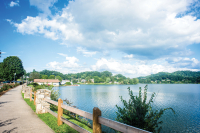Finding your roots in Appalachia
 Ronan MacGregor didn’t know where he came from.
Ronan MacGregor didn’t know where he came from.
He knew he was of Scottish decent, but that was about it. It wasn’t until he moved to Macon County several years ago and wandered into the Scottish Tartans Museum in downtown Franklin that he began digging into his family’s past.
“Folks get to a point in their life that they know who they are, but they want to know who their parents were, who their grandparents were, and so they start the journey backwards,” he said.
Opened in 1988, the museum (originally located in Highlands) is dedicated to promoting and educating about the Highland tartan dress, or kilt. It’s the only place of its kind in the world.
MacGregor befriended the head of the museum, became a volunteer and soon found out the storied and rich past of the MacGregor clan. Now, he has taken over his friend’s position and is currently the director of operations for the museum.
Related Items
“It’s always a learning process, finding our your heritage, and knowing where to look is part of the fun and adventure of discovering your genealogy,” he said. “Every experience is different for each individual that starts looking.”
Displaying more than 500 of the most common family, clan and district tartans, an onsite database houses more than 6,000 registered designs. All of this is alongside a museum filled with information on the long history of the kilt and the massive influence the Scottish had on the development of Western North Carolina.
“The museum is a great historical and cultural resource where anybody who wants to know more about their Scottish ancestors can come in and we’ll search their past for them,” MacGregor said.
Tying into the museum is the 16th annual Taste of Scotland & Celtic Festival, which will be taking over downtown Franklin on June 13-16. The event features everything Scottish — live music, parade with pipers, kids activities food, craft demonstrations and Highland games, which showcases caber and hammer throws.
“Over 80 percent of original Macon County residents are of Scottish decent. The influence is huge,” said Doug Morton, chairman of the Taste of Scotland. “This festival is all about the Scottish heritage and how they settled this area.”
Both the museum and the festival work together to preserve and perpetuate the deep Scottish ties to Southern Appalachia. Over the last few hundred years, the Scots emigrated from their homeland to begin a new life in America. With the rich soil and mountain resemblance to the Scottish Highlands, WNC seemed the ideal place to start anew.
“When the Scots first came here, they blended in well with the Cherokee, they traded with them, had the same fundamental and family values as them, and each had numerous clans,” Morton said. “Scotsmen are very dedicated, very hard working, believers in family and education. We work hard and we play hard, which makes us a really unique group of people.”
As he strolls through the museum, MacGregor discusses and points out the history and importance of the kilt, which dates back to 400 A.D. What originally started out as a four-yard long heavy wool blanket soon became the modern day kilt. Scotsmen would brave the cold and damp elements with the fabric draped over their shoulders.
“Prior to the Industrial Revolution, the kilt was more of an art form, where weavers would pick the colors and patterns they liked and create specific pieces, each one sometimes completely different from the next,” he said. “But, with the Industrial Revolution and mass production, manufacturers soon named each design after a different clan to not only identify the material, but also to go back to what these patterns originally signified.”
When working, they would tuck and belt the kilt around their waist, which could create pockets or a hood cover, depending on the tuck method. These methods soon evolved into the modern day version of the kilt. With the extensive kilt display at the museum, there’s also an exhibit on Cherokee and Scottish interactions, a weapons display and elaborate descriptions of the history of the culture in Southern Appalachia.
“These folks coming here from Scotland came to America to have the opportunity to own their own land,” MacGregor said. “They have that sense of belonging with owning your own home and property, and that was a powerful motivator to why they came to Western North Carolina.”
With the constant flow of new residents to the region, Morton stresses that now — more than ever — is the time to truly preserve the delicate and intricate Scottish history here.
“First of all, I’m a proud Scotsman, and I’m also a proud resident of Franklin,” he said. “More and more new people are moving here, and many of the older locals are dying out, so it’s important to keep this heritage alive, for people to know where they came from.”
Want to go?
The Scottish Tartans Museum is located on 86 East Main Street in downtown Franklin. It is open 10 a.m. to 5 p.m. Monday through Saturday. Admission is $2 for adults, $1 for children ages 6-12. As part of The Taste of Scotland & Celtic Festival, the museum will be open for free tours all day Saturday, June 15, from 1 to 5 p.m. Sunday, June 16. 828.524.7472 or www.scottishtartans.org.
The Taste of Scotland & Celtic Festival
June 13 TOS Golf Tourney at Mill Creek country Club. Clan gathering at Mill Creek Restaurant following the game. 828.524.4653.
June 14 Shortbread Contest, Ceilidh (Party) with music downtown by the Juniper Trio at 5 p.m. Vendors from 5:30 to 9 p.m.
June 15 Downtown celebrations and vendors from 9 a.m. to 8 p.m. 1K Rob Roy Race at 8:30 a.m., with 5K Braveheart Race at 9 a.m. Live music throughout the day on Main Street. Scott Medlin and his group will demonstrate real highland games such as the saber throw and hammer throw in field next to Ace Hardware, two blocks from downtown. Best Scottish window contest to be judged by the people enjoying the festival. Scottish Tartans Museum will be open with free admission all day and with four guided tours.
June 16 Kirkin’ O’ the Tartans at 11 a.m. in the First Presbyterian Church on Church Street. Scottish Tartans Museum free admission from 1 to 5 p.m., with one guided tour at 2 p.m.









